The 5 Best Knife Sharpeners in 2024 Tested and Reviewed
We spent more than a year testing and rating dozens of models so you can have the best knife sharpener for your home kitchen.
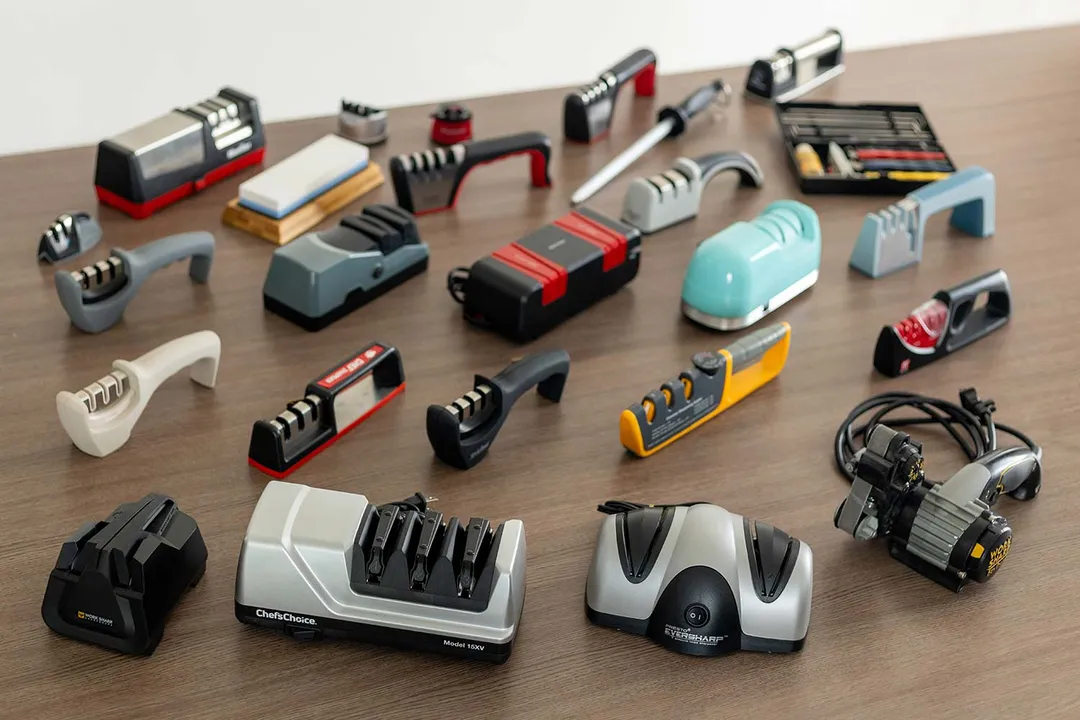
With time and use, even the finest knives will eventually become blunt. One option is to throw the dull knives away and get new ones, but a more economical strategy may be to invest in a good kitchen knife sharpener and enjoy your trusty blades for decades.
To find the best knife sharpener, we spent more than a thousand dollars buying dozens of devices and used piles of lemons, ripe tomatoes, chicken breasts, and beef tendons as test subjects. And now, with all that experience under our belt, we can tell you exactly which ones perform best.
How We Test Knife Sharpeners
All our sharpeners are rated for Performance, Ease of Use, and Design. However, the exact composition of the tests differ to reflect the nature of each sharpener category.
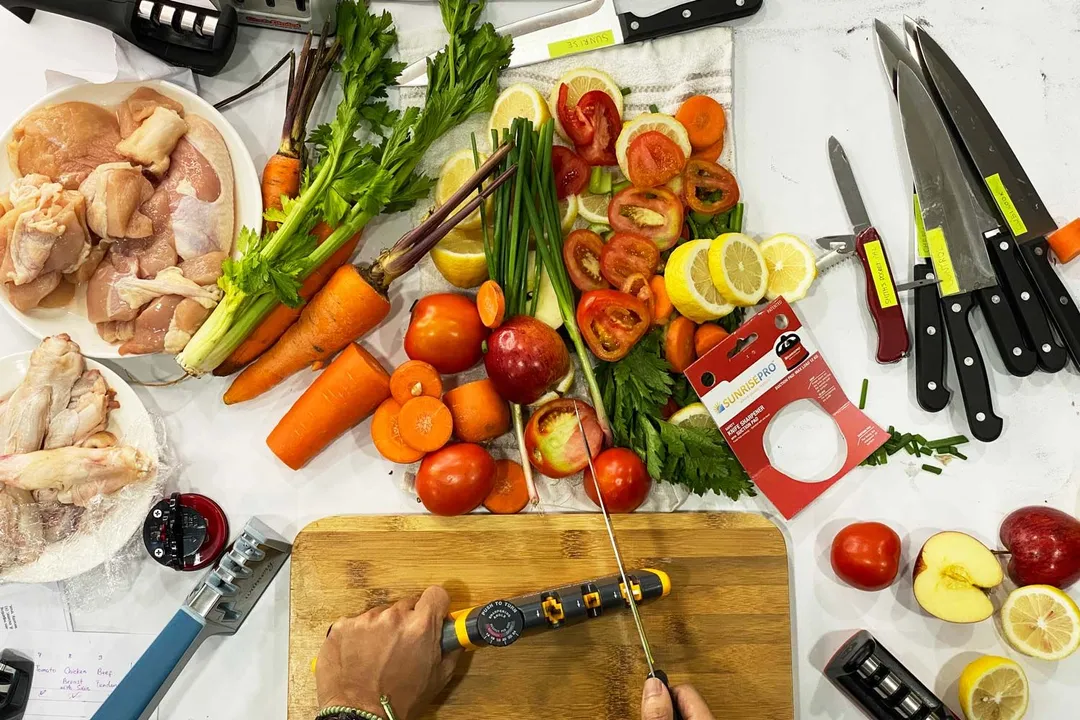
With manual sharpeners, the performance tests consist of maximum sharpness achieved, sharpening time to reach workable sharpness, edge smoothness, and material retention. The performance rating for electric sharpeners, meanwhile, depends on speed, edge quality, material retention, and continuous operation time.
For design and ease of use, we factor in build quality, user-friendliness, and how accommodative the sharpener is to the various types of knives.
How We Picked
Our Best Knife Sharpener to Buy pick is the one with the highest rating across all product types. Following that, the devices that got the highest ratings in each category are chosen to represent their respective categories.
As new products hit the market, our testing efforts expand. As such, our best picks change as we discover better products or better ways to measure their effectiveness.
Our Top Picks
After testing a bunch of knife sharpeners, we compiled a list of the best performers in each category.
1. Best Overall: Chef’s Choice Trizor XV Electric Knife Sharpener
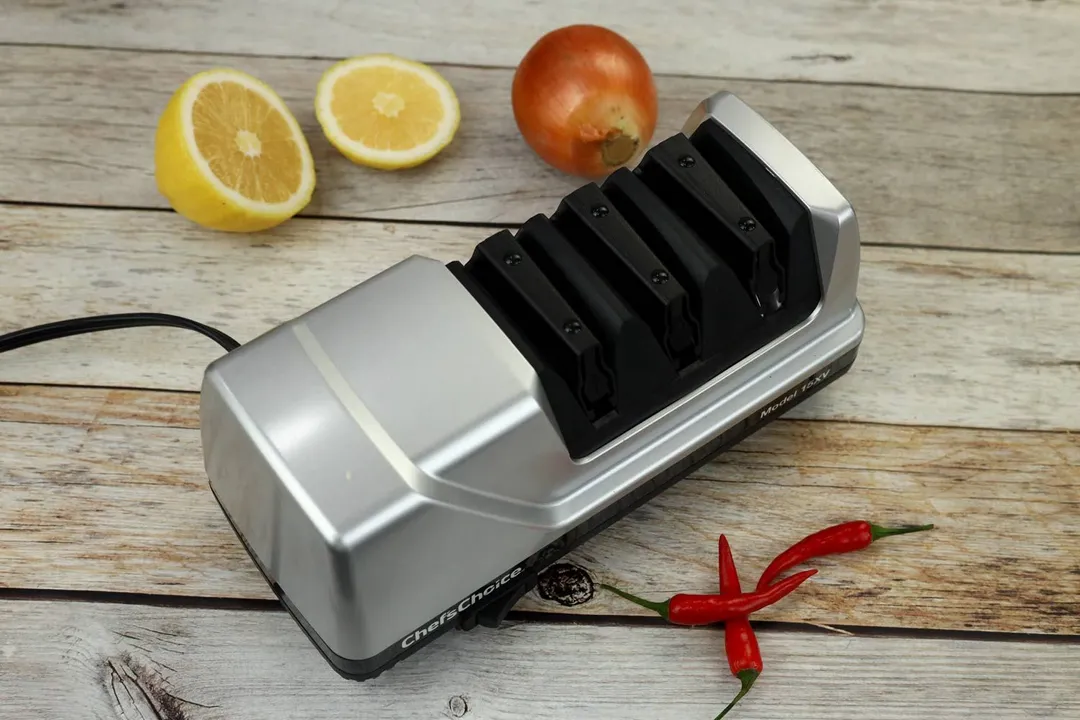
Things We Like
- Strong, solid build, great stability
- Excellent sharpness
- Long operation time without overheating
- Sleek design
- Easy setup and cleanup
- Long warranty (3 years)
Things We Don’t Like
- No grind angle options
- Shaves off a lot of knife material
The Chef’s Choice Trizor XV gained top spot for the best knife sharpener for two reasons. It delivered great results every time while requiring minimal time and effort. Additionally, the practical (and attractive) design made it safer than most to use in a kitchen area.
The Trizor XV sharpens at a 15 degree angle, which results in clean and precise cutting. It took 5 minutes of sharpening before our previously blunt test knife could slice through raw beef tendon—the toughest food on our Sharpness Scale.
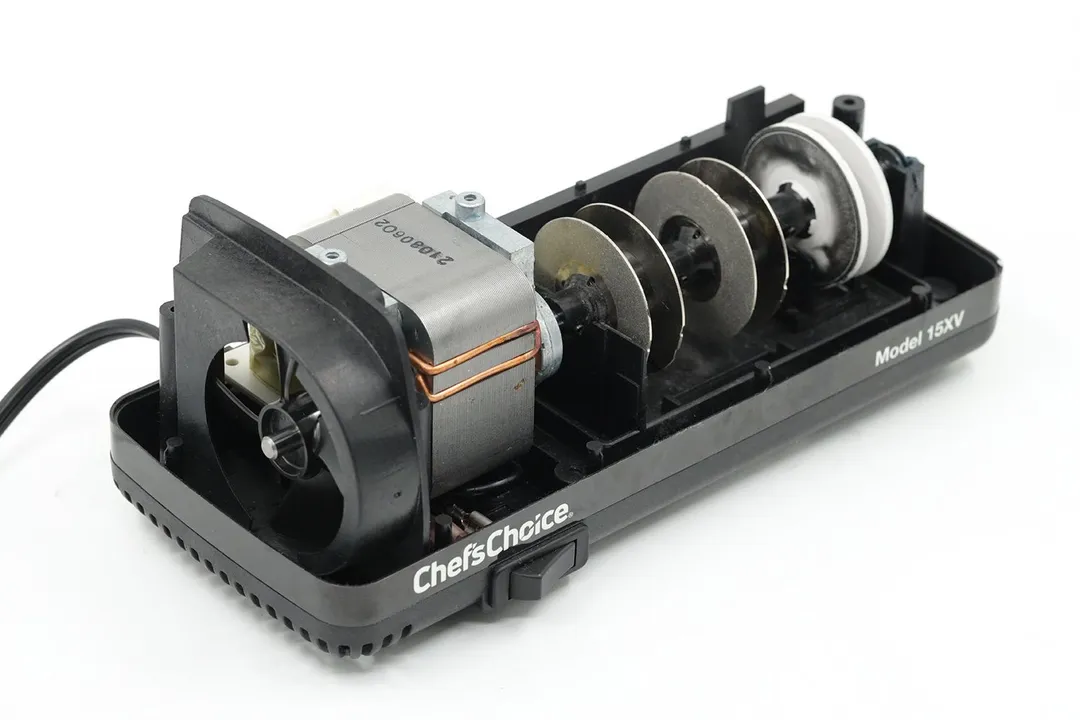
Featuring three stages of sharpening, the Trizor creates a multi-facet edge with good height contributing to better edge retention. It did remove quite a bit of knife material, but the knife stays keen for a longer time, requiring less sharpening.
Typical of electric sharpeners, you can’t adjust the grind angle with the Trizor XV. It scored lower here compared to WorkSharp Ken Onion, which allows adjustments between 15 and 30 degrees. On the other hand, the Trizor XV is a lot more straightforward to set up and safer to use. If you’re a home cook who wants a professional level of sharpness without sweating over the process, it’s the one for you.
Read our full Chef’s Choice Trizor XV Electric Knife Sharpener in-depth review
2. Best Manual: Cubikook CS-T01 Knife Sharpener
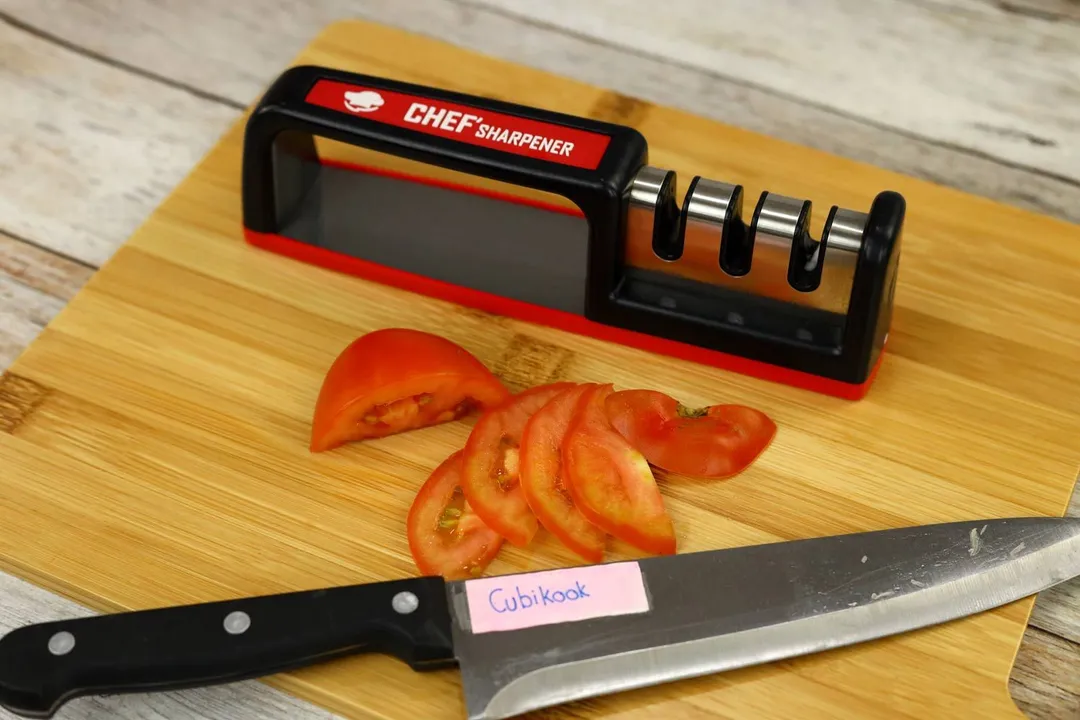
Things We Like
- Strong, solid build, great stability
- Excellent sharpness
- Long operation time without overheating
- Sleek design
- Easy setup and cleanup
- Long warranty (3 years)
Things We Don’t Like
- No grind angle options
- Shaves off a lot of knife material
We’ve repeatedly tested a bunch of manual knife sharpeners and the Cubikook CS-T01 has maintained its place at the top without fail. We recommend it for home cooks who are looking for an affordable sharpener that’s also safe and effective.
The Cubikook CS-T01 struck a fine balance between sharpness and edge integrity. It received some of the highest ratings in our edge smoothness and material retention tests, and was also among the top tier in both speed and effectiveness. It took only 1.5 minutes to restore sharpness on a useless dull knife. In normal conditions, the sharpener will prep your knife for any challenging cutting task in less than 30 seconds.
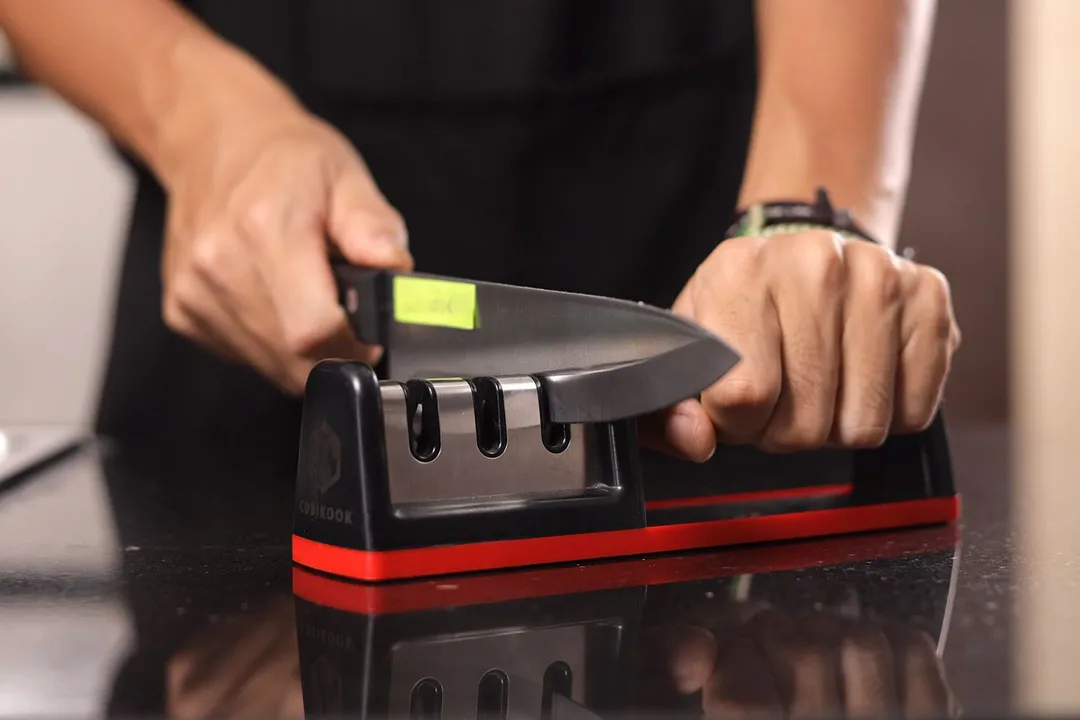
With wide sharpening slots placed in a natural progressive order, the sharpener is intuitive to use. Its working section is tightly fastened to a wide, flat, and solid base. This design lowers the center of gravity and effectively eliminates the risk of flipping during sharpening.
Its weak points include a brand label that starts to peel off after a few months, which a little glue can fix. Also, make sure you’re gentle on the white ceramic rods—they tend to become loose more quickly than the other abrasives.
Read our full Cubikook CS-T01 Knife Sharpener in-depth review
3. Best Value: Presto EverSharp Knife Sharpener
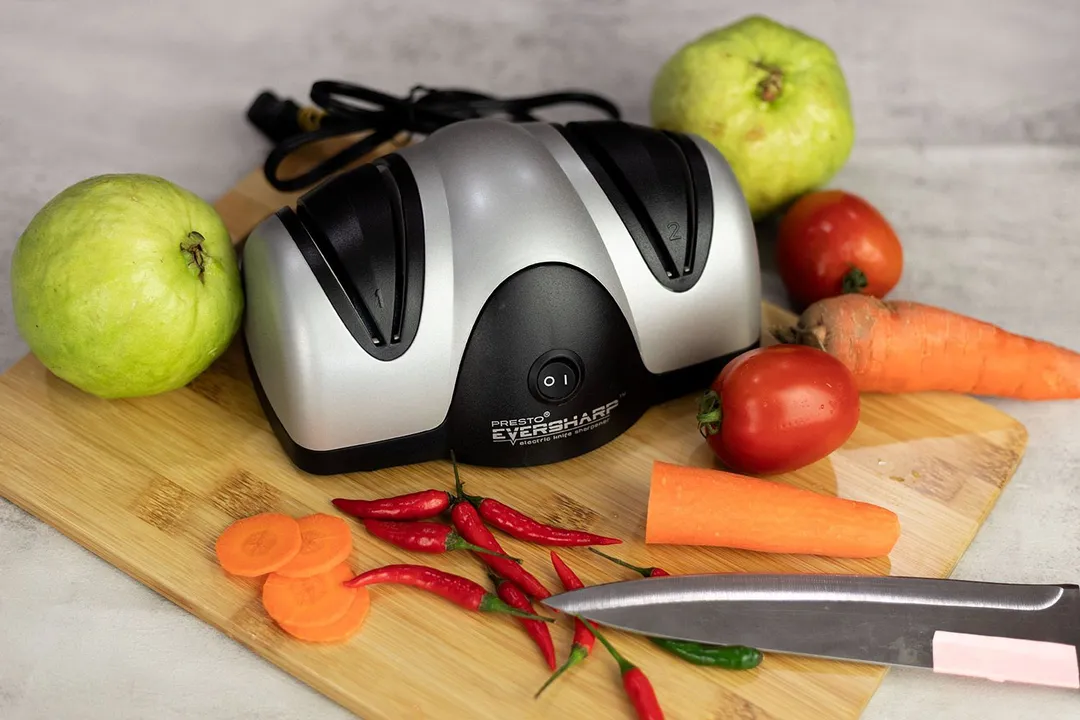
Things We Like
- Quick sharpening without removing too much metal
- Simple design
- Intuitive working section
- Affordable price
Things We Don’t Like
- Slippery grip
- Flimsy base pad
The Presto 08800 EverSharp electric knife sharpener is a practical choice for a home cook on a budget of less than $50. It’s not exceptional, but is fast, effective, durable, and easy to use.
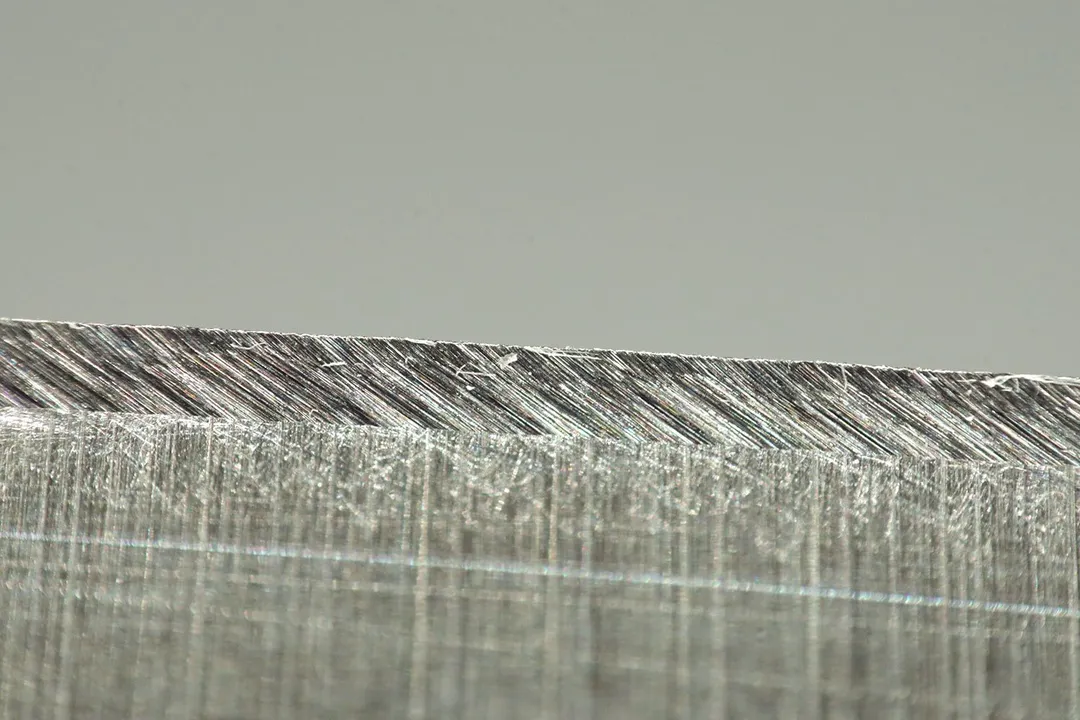
It took less than 5 minutes to bring a keen edge to the sandpaper-destroyed blade. While it didn’t produce as fine an edge as the Trizor XV or the Ken Onion, it was much easier to get even edge bevels with this one. The edge height was substantial for a 20 degree grind angle. Therefore, the knife should stay keen for a long time between sharpenings.
The Presto 08800 EverSharp features a user-friendly design. As long as you don’t apply too much pressure or push the knife too far into the slit, the machine will easily sharpen several knives in succession without issues.
While the materials appear very average, the sharpener as a whole is sturdy and solid. We haven’t noticed any sign of wear and tear on the stones nor the exterior after more than a year. If you’re on a budget and don’t need to sharpen every knife to its original angle or have a mirror-like finish, we highly recommend this sharpener.
Read our full Presto EverSharp Knife Sharpener in-depth review
4. Best Electric System: Work Sharp Ken Onion Electric Sharpener
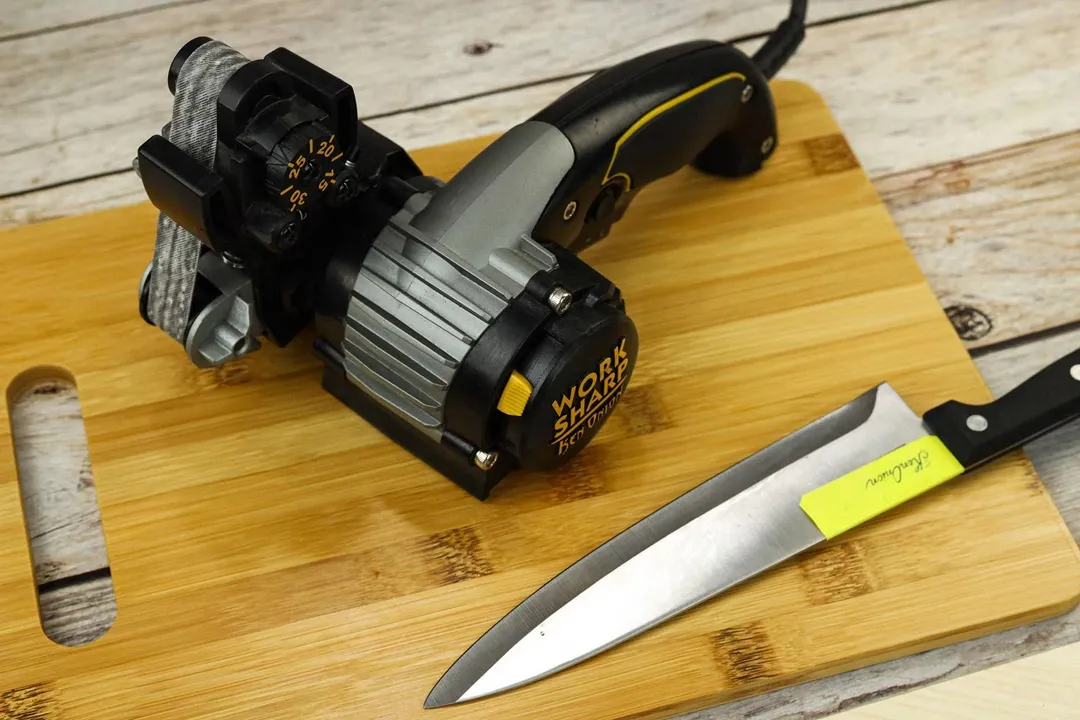
Things We Like
- It accommodates different edge angles and blade types
- You’re in control of the speed
- It can produce a mirror-like finish
- It works on various tools other than kitchen knives
Things We Don’t Like
- It throws dust into the air
- There’s a learning curve
- It’s tricky to get even bevels
If you want the convenience of an electric sharpener but are also particular about your blades, the Work Sharp Ken Onion is the answer. We’ve tested more than a dozen devices, and no other can beat it in terms of versatility.
The Work Sharp Ken Onion is equally adept at fixing damaged knives and polishing fine edges to a mirror-like finish. While such heavy-duty tasks required more time, sharpening a dull kitchen knife to highly serviceable levels took mere minutes.
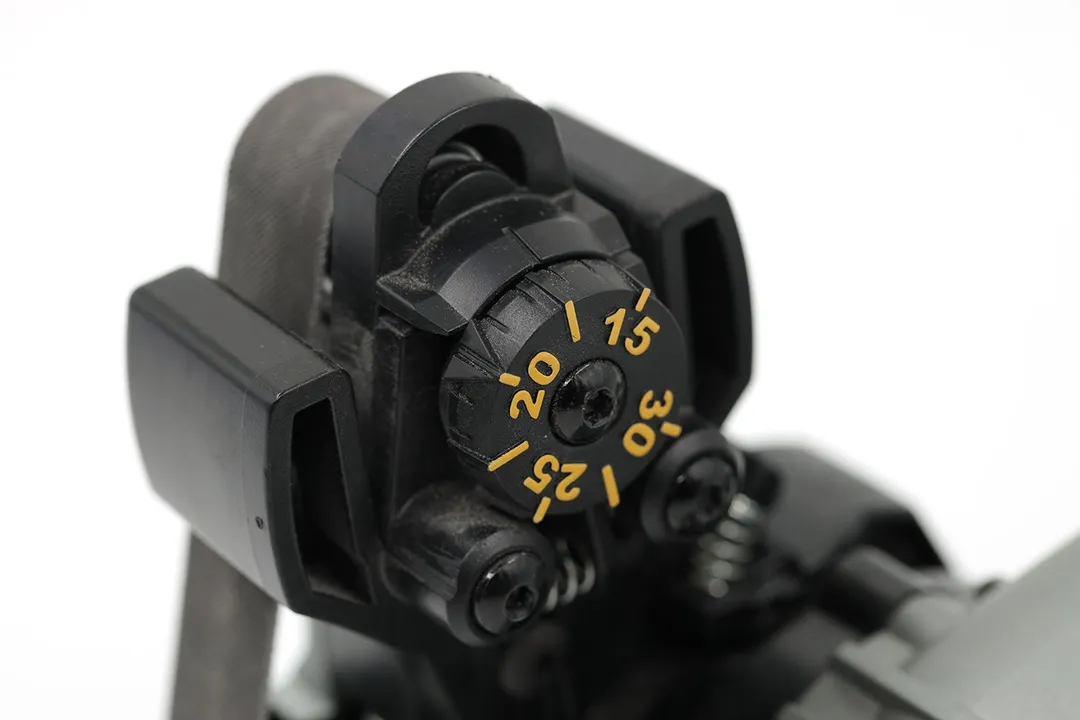
While original Work Sharp offered only two angle choices, the Ken Onion sharpens to any angle between 15° and 30°. Even the sharpening speed is adjustable.
Of course, such versatility comes at a cost: The learning curve is steeper on this device than most. Setup can be a bit of a hassle, though it does get easier with time. We also found that keeping the edge even is more an art than a science: It’s very easy to end up with a bevel that’s broader on one side than the other. This might be preventable if you pay close attention and keep the knife straight and parallel to the guide at all times.
Read our full Work Sharp Ken Onion Electric Sharpener in-depth review
Nearest Competitors
Here are some other decent sharpener options if you're looking for more.
- The Priority Chef manual sharpener proves highly proficient, swiftly honing a sharp edge without excessive material removal from your knife. Its simple design and low base ensure a safe sharpening process. We have doubts over the durability of its base pad, but if you can look past that, it’s an affordable option worth exploring.
- The Work Sharp Culinary E2 electric sharpener is lightweight, compact, and easy to use, despite having some delicate components. It’s great for casual use and can maintain your knives at a sharpness level suitable for most cutting needs, but isn’t a practical option if you’re looking to fix more substantial edge damage or re-bevel the knife.
- If you want to sharpen with whetstones but find it challenging to maintain a specific edge angle, the Lansky Deluxe 5-stone kit is a good starter kit. Featuring five stones of different grits, guide rods, and a knife clamp, it allows sharpening to various angles with satisfying precision. The small stones mean it takes quite some time to bring an edge to a knife. However, if you have the patience, you may grow to enjoy the process.
FAQ
The amount of time it takes to sharpen a knife depends on various factors. Per our estimation, here's the time it typically takes to bring a chef's knife to the maximum level of sharpness that the sharpening device allows:
- Sharpening rod (for honing): 30 seconds
- Pull-through knife sharpener: 1 – 3 minutes
- Electric pull-through sharpener: 5 – 7 minutes
- Electric sharpening machine with abrasive belts: 5 – 10 minutes
- Sharpening stones: 10 – 30 minutes
The many teeth on a serrated knife require a tiny device to get in between them. You can use a pull-through sharpener, stone, or sharpening band to remove some burrs from the pointed teeth, but it will only go so far. If the teeth are large enough, you may sharpen them one by one with a diamond-coated tapered rod.
Western/European style knives, designed for dealing with animal-based foods and tough vegetables, typically have a large, strong blade with a 20- or 22-degree edge. Asian/Japanese knives, meanwhile, are intended more for fish and softer vegetables, and have finer angles (13 – 15 degrees). Wider-angle blades are stronger, while finer angles allow for more precision. Some chef's knives are hybrids, with edge angles between 15 and 18 degrees.
Knives come in various shapes and blade grinds. It is impossible for a single sharpener to fix and polish all of the types, but you should aim to find one that can handle the majority of your knives. It’s best to find a machine that allows flexibility in terms of edge grind and angle, or learn how to work a semi-manual or fully-manual tool (think whetstones) to keep your knives sharp and in tip-top shapes.
A new knife usually comes reasonably sharp. The factory has sharpened it to a specific angle and given it bevels that are suitable for the intended tasks. When sharpening the knife by yourself, you potentially change the bevel(s) and alternate the edge angle.
If you have little experience in knife sharpening, it's best to use a new knife until it becomes dull before sharpening it.
The push stroke, aka edge leading stroke, compacts the steel and removes more material. It is the more effective style when you want to fix a damaged edge, but it also causes chipping. The edge-trailing stroke, meanwhile, creates a keener edge, but because it stretches the steel, it tends to create foil burr. We recommend the push stroke for edge rejuvenation. You can finish the sharpening session with the pull stroke, but stop after about 30-40 laps before the foil burr forms.
If you're using a manual or an electric sharpening device, always pull the knife starting at the heel. Never push or you may risk destroying the knife's edge.
Our Expertise
Anh Ngo and Luna Regina have been researching and reviewing knives and sharpeners since 2019. They have honed their knife knowledge and skills with numerous visits to knife forums, conversations with professional chefs, sharpening workshops, and most importantly, tons of food.
Along with the Test Lead, Lap Vo, Anh and Luna developed the test methodologies for manual and electric knife sharpeners after a total of 2 months drafting and trial testing the sharpeners. The team spent an additional 30+ hours at the lab destroying 25 knives on sandpaper, then restoring them and testing them out on different food ingredients. They also disassembled and reassembled every of the 20+ sharpeners reviewed on HealthyKitchen101, inspecting the devices thoroughly and rating their design and durability. The team has sliced countless pounds of lemons, tomatoes, and beef tendon, among other foods, before they found the best knife sharpeners.
About your guide
Luna Regina is an accomplished writer and author who dedicates her career to empowering home cooks and making cooking effortless for everyone. She is the founder of HealthyKitchen101.com and HealthyRecipes101.com, where she works with her team to develop easy, nutritious recipes and help aspiring cooks choose the right kitchen appliances.
Anh Ngo is a writer with 9 years experience at different media outlets, covering from public news and events to product testing and analysis. At HealthyKitchen101, she works across different departments, communicating closely with its network of writers, editors, and health, tech, and search engine experts to provide a meaningful and pleasant reading experience for visitors.
Lap is Head of the Research, Testing, and Review Team (RTR Team) at HealthyKitchen101.com, where he directs and supervises the testing of kitchen gadgets and appliances.
Nguyen Ntk is a graphic designer, photographer, and videographer whose philosophy centers around respecting and celebrating the beauty of reality. Through his lenses, Nguyen strives to capture the true essence of objects and events, showcasing and highlighting authentic features without distortion or exaggeration.



